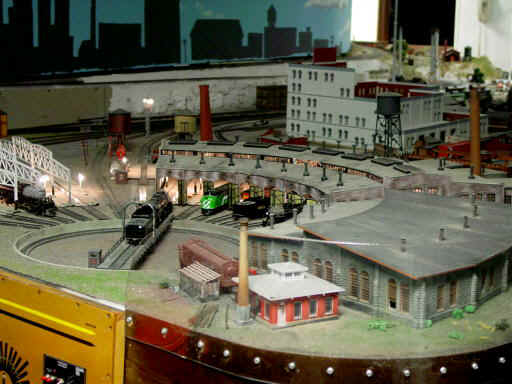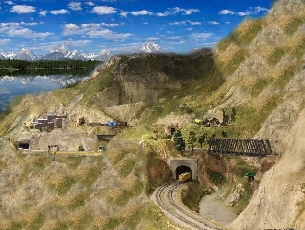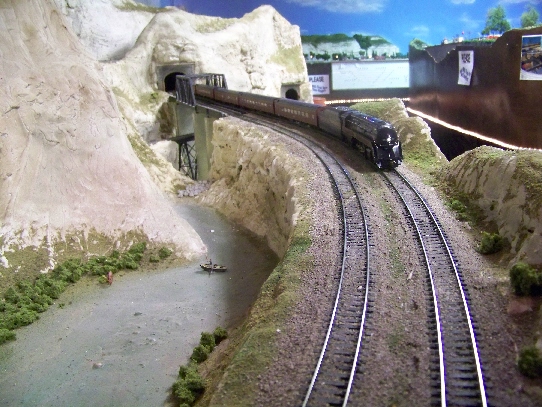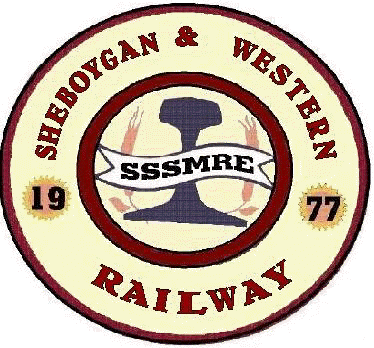|
|
HOME CALENDAR OF EVENTS LOCOMOTIVE TYPES SIGNALING DCC MODULAR LAYOUT MEMBERS MEMBERSHIP APPLICATION OUR HISTORY LAYOUT TOUR FALLEN FLAGS CONSTITUTION
|
|
Page 3
We had decided initially on conventional block
control over DCC to keep costs down for our younger members. That
system worked well over the first ten years, however with the cost of
decoders now within reach of most modelers, the decision was made to
convert the layout to
|
| Turnouts (154 of them) were powered by Tortoise machines controlled from various panels. That system worked well for many years, powered by a 6 amp +- power supply. Later, 44 turnouts were controlled by Digitrax stationary decoders, with control switched to the dispatcher using Railroad & Co.® software during operating sessions and Open Houses. Local panel control for those turnouts was disabled during those times with a simple click of the mouse. Fully operational ABS signaling, also controlled by the computer, was installed throughout the layout. The same was done to the modular layout, which gets setup at shows frequently. |
 |
This is the 18 stall Pawlus Roundhouse Facility. It is complete with ash pit, wash stand, coal and water towers, power house, and repair facilities. The interiors are fully detailed with many plaster castings, including the pits. The nearest one is a South River Model Works kit with Grant line windows. This is one of the two areas that were preserved intact when the layout was disassembled. They are incorporated into the new layout, which is now operational. |
| The mountain area featured dramatic floor to ceiling scenery with concealed access throughout. The era being modeled was generic with buildings and details able to accommodate steam to present. |  |
| The area was Eastern coal areas to the Midwest industrial to the Rocky Mountains. There was also a large passenger depot with a city above it with trolley and interurban lines and an intermodel yard. We tried to create raw material, manufacturing, and end-user industries to complement each other and provide a reason for the railroad to move products from one location to another. In keeping with our purpose of preserving railroad history, we needed to show how railroads served the nation. To that end, I think that we accomplished that goal. For raw materials, we had coal and ore mines, forestry, cattle ranching, and oil fields to complement power plants, a refinery, a smelting plant, lumber mills, meat processing, automotive, and other industries. Just about every conceivable product that is moved by rail was represented here. This helped to explain how real railroads operate. |
 |
The finished Devils Gulch with tracks navigating through it on three levels. Scenery here runs from 4" above the floor all the way to the ceiling. The lower track is a branch line serving the Argentine staging yard, with the double track mains above it. Impressive rock formations highlighted this area. |
During the first 15 years in our new home,
membership has evolved tremendously from the original 18 members. The
group has found that the acquisition of a permanent home has been a
great help in recruiting new members. The enormous progress made on the
layout during that time was also quite an attraction, especially with
the addition of DCC. The Railroad Museum is open to the public every
Tuesday and Thursday. Operating sessions, each Friday, run
point-to-point, as the real railroads do, but the design permits
continuous loop operation during the two-day open houses held four
times a year. The intent is to show as realistically as possibly how
real railroads conduct their business. The new layout was designed to maintain that standard.
Over the 15 year lifespan of the layout, operations had proven that the time spent early on was well worth the effort. We needed a layout that would operate as flawlessly as possible and we found it. The amount of maintenance needed had been very minimal. Only a few switch machines (out of 150) have had to be replaced and two power supplies repaired. The members were very pleased with the way the layout was working. Special thanks should be given to the following: Ken Bailey, Roger Rybacki, Dave Reinert, Dick Pool, Al Myer, Greg Heberlein, Brian Harp, and the late Carter Pawlus, Terry Piaskowski, Al Wagner, Joe Windmiller, and Jerry Lampe. These twelve people gave countless hours of their time during the early stages of construction to insure that those who came later could enjoy a real jewel. Three of these twelve are still active. As with any project of this type, new and better ways of doing things are always being discovered, for example, one of the latest innovations was computer control and ABS signaling, features now added to our modular layout. The layouts will always be evolving. One thing is for sure, however. It will be here for a long time to come for people to enjoy. Update April 2010: The interior of the building has received a major makeover and work is progressing toward getting it ready for it's new use. The public is delighted that we are still here. Update: December, 2010 The insulating, front walk, and interior renovations on the main floor are complete. Work has already begun on the first four of seven planned layouts, one in O scale and two in N scale. There will be four additional layouts, one O scale meant for children, one in S scale, one in G scale, and one in HO scale, the largest of the seven, covering three walls in a wrap-around fashion. That layout will include two complete areas salvaged from the original layout. Update: May 2011 To better reflect the purpose of the building, the name of it has been changed to the Sheboygan Railroad Museum. The number of layouts under development have increased to seven, in six different scales. They are G, HO, N, O, S, and Z scales. Two of them are N scale, and two are O scale, including a kids layout that visiting children can have fun with. There are also areas set aside for displays of historical artifacts, along with an extensive library of books, periodicals, and videos depicting the history of railroads, as well as articles on modeling the prototype. As always, there are people on hand to answer any question a visitor may have. Update: September 2011 The exterior of the building has been repainted in railroad colors, specifically BNSF Cream and Wisconsin Central Maroon. It dramatically changed the look of the building and is complimented by the new brick walkway.
|
||
|
Update January 2012 The smaller N scale layout is nearly complete with scenery, buildings, and details. The HO scale layout has bench work complete and work is progressing, getting the two saved areas in place, and roadbed installed. The hope is to at least have trains running by the next Open House. Update June 2012: The S scale layout is operational with scenic features now being added. The HO layout has track being laid and wired. The Helix is now installed to allow access to the second level. Concurrently, wiring is going on underneath. Update September 2012 The HO layout now has the lower level track installed, wired, and fully operational with automation. Framework has begun on the upper level while continuing to dress out the lower level. Work is also progressing on the larger N scale and the S scale layouts. See photos:
Update: December, 2012 Six of the planned seven new layouts are now operational, some with scenery on portions of them. One has scenery complete, so work is now concentrated on the remaining layouts. The HO layout is fully automated during public sessions. Repeat visitors marvel at the speed of progress since their last visit. Update: May 2013 Seven new layouts are operational and in varying stages of scenery. The HO layout has the lower level complete with work under way on the upper level. The smaller N scale layout is complete with details added, as is the Lionel layout.Update: November 2016 Seven layouts are fully functional, with the upper level of the HO layout mostly complete with a lot of scenery added. The Museum is now open Tuesdays, Thursdays, and Saturdays. Update: January 2019 The entire interior is occupied by many restored railroad antiques and model layouts in six different scales, including one the kids can run. Being open several days each week now draws quite a crowd, and the quarterly Open Houses are very popular. |

To take a tour around the new layouts.
HOME CALENDAR OF EVENTS LOCOMOTIVE TYPES SIGNALING DCC MODULAR LAYOUT MEMBERS MEMBERSHIP APPLICATION WEBRINGS - LINKS OUR HISTORY LAYOUT TOUR FALLEN FLAGS CONSTITUTION
Photos and text on this site are © 1977 - 2019 Sheboygan Society Of Scale Model Railroad Engineers, Ltd. All rights reserved.
Updated: Thursday, January 31, 2019